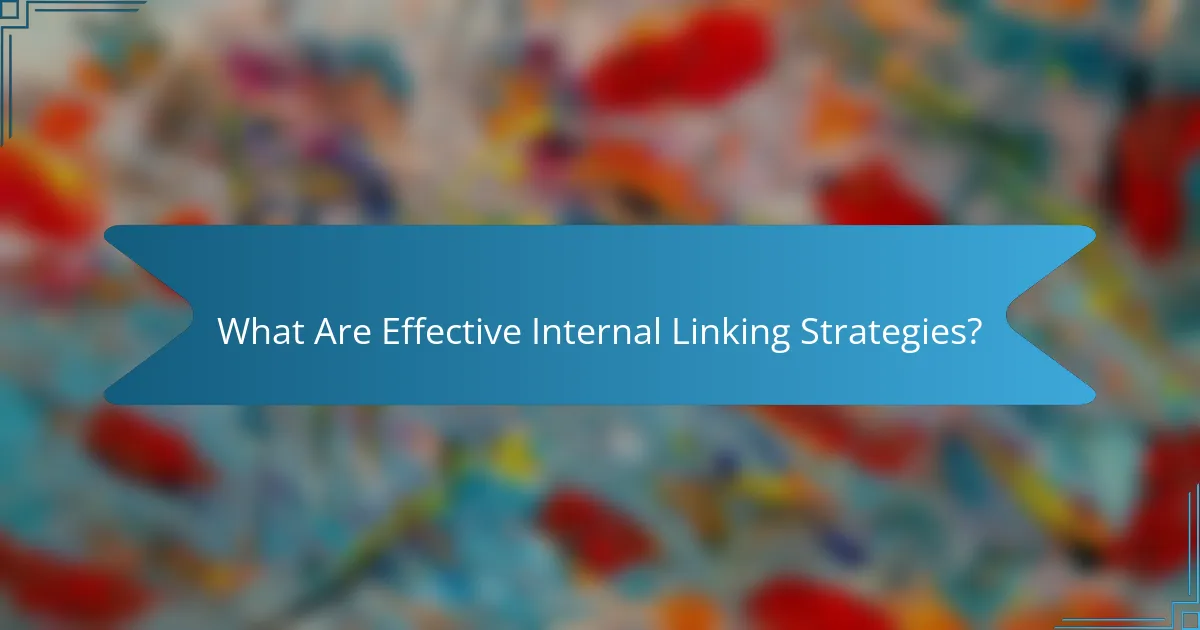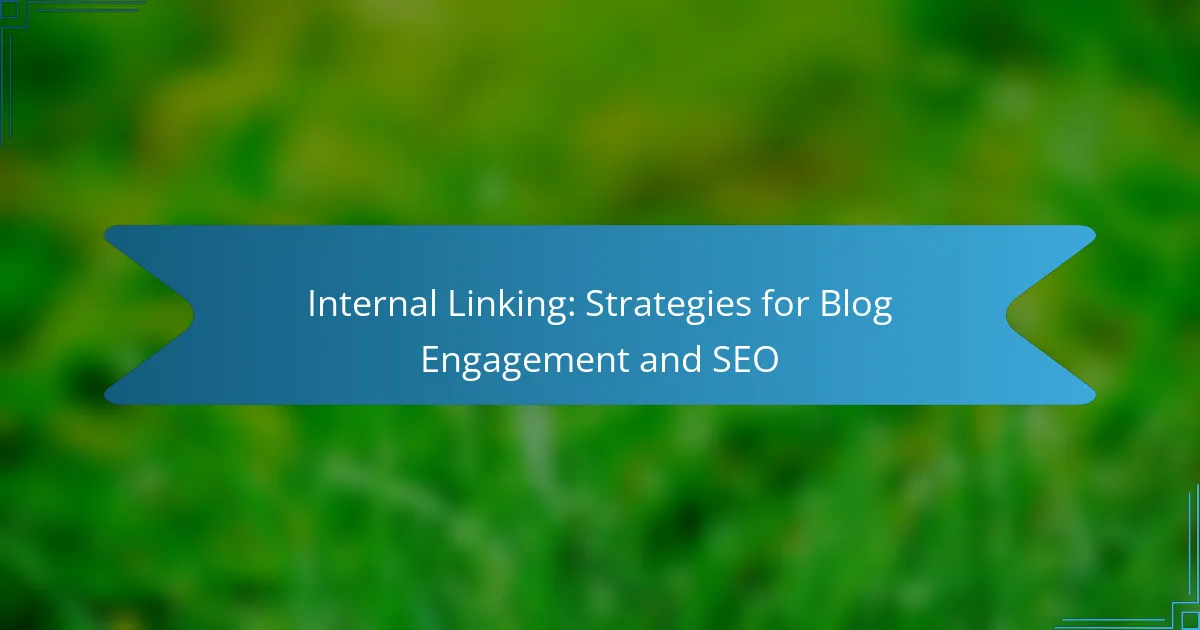Internal linking is a powerful strategy that enhances blog engagement by directing readers to related content, thereby increasing their time on your site. This approach not only enriches the user experience but also optimizes your site for search engines, helping them better understand your content structure. By implementing effective internal linking techniques, you can significantly improve both user interaction and SEO performance.

How Can Internal Linking Improve Blog Engagement?
Internal linking can significantly enhance blog engagement by guiding readers through related content, keeping them on your site longer. This strategy not only improves user experience but also boosts SEO by helping search engines understand your site’s structure.
Enhances user navigation
Internal links create a clear path for users to follow, making it easier for them to find relevant articles and information. By linking to related posts, you help readers discover more content that interests them, which can lead to a more satisfying experience.
For effective navigation, ensure that your anchor text is descriptive and relevant to the linked content. This helps users know what to expect and encourages them to click through.
Increases page views
When readers find engaging content through internal links, they are more likely to explore additional pages on your blog. This can lead to a noticeable increase in overall page views, which is beneficial for both user engagement and SEO metrics.
To maximize page views, consider placing internal links strategically within your posts, such as in the introduction or conclusion, where they can capture attention effectively.
Boosts time on site
Internal linking can significantly extend the time users spend on your site by encouraging them to read multiple articles in one session. The longer visitors stay, the more likely they are to engage with your content and return in the future.
To enhance this effect, create content clusters around specific topics, linking related articles together. This not only keeps readers engaged but also establishes your authority on those subjects.
Reduces bounce rate
A well-structured internal linking strategy can lower your bounce rate by encouraging users to navigate to additional pages rather than leaving after viewing just one. A lower bounce rate signals to search engines that your content is valuable and relevant.
To effectively reduce bounce rates, ensure that your internal links are relevant and provide real value to the reader. Avoid excessive linking, which can overwhelm users and lead to confusion.

What Are Effective Internal Linking Strategies?
Effective internal linking strategies enhance user engagement and improve SEO by guiding visitors through your content and helping search engines understand your site structure. These strategies include contextual linking, navigation menus, and related posts sections, each serving a unique purpose in enhancing the user experience.
Contextual linking
Contextual linking involves embedding links within the body of your content, directing readers to relevant articles or pages. This method not only provides additional value to the reader but also helps search engines establish the relevance of your content. Aim to include 2-5 contextual links per article, ensuring they are naturally integrated and relevant to the topic.
When implementing contextual links, use descriptive anchor text that clearly indicates the linked content. Avoid generic phrases like “click here” and instead opt for specific terms that reflect the target page’s subject. This practice enhances both user experience and SEO.
Navigation menus
Navigation menus are essential for guiding users through your website. A well-structured menu should include links to key categories, popular articles, and important pages, making it easy for visitors to find what they need. Consider using a dropdown menu for subcategories to keep the navigation clean and organized.
Ensure your navigation menu is consistent across all pages and mobile-friendly. A responsive design allows users to access your content easily, regardless of the device they are using. Regularly review and update your navigation to reflect new content and changes in user behavior.
Related posts section
A related posts section at the end of each article encourages further exploration of your content. This feature can significantly increase page views and reduce bounce rates by presenting readers with additional topics of interest. Include 3-5 related posts that are contextually relevant to the current article.
To optimize the related posts section, consider using algorithms that analyze user behavior or tags to suggest articles. This personalization can enhance user engagement. Regularly monitor the performance of your related posts and adjust them based on analytics to ensure they remain relevant and effective.

How to Implement Internal Links for SEO?
Implementing internal links effectively enhances SEO by improving site navigation and distributing page authority. Focus on strategic placement of links within your content to guide users and search engines through your website.
Use keyword-rich anchor text
Using keyword-rich anchor text helps search engines understand the context of the linked page. Choose descriptive phrases that accurately represent the content of the target page, which can improve its ranking for relevant search queries.
Avoid generic phrases like “click here.” Instead, use specific keywords, such as “learn more about SEO strategies,” to enhance relevance. This practice not only aids SEO but also provides clarity to users.
Link to high-authority pages
Linking to high-authority pages within your site can boost your own pages’ credibility. Identify content that is well-researched and has garnered backlinks from other reputable sources, as these links can enhance your site’s overall authority.
Consider creating a hierarchy where your most valuable content is linked from various other pages. This strategy not only improves SEO but also encourages users to explore more of your high-quality content.
Maintain a logical structure
A logical structure for internal linking helps users navigate your site intuitively. Organize your content into categories and subcategories, ensuring that links connect related topics seamlessly.
Utilize a site map or a clear navigation menu to guide users. Regularly audit your links to ensure they are up-to-date and relevant, which can prevent broken links and enhance user experience.

What Tools Can Help with Internal Linking?
Several tools can enhance your internal linking strategy by providing insights into link structure, keyword opportunities, and optimization techniques. Utilizing these tools effectively can improve both user engagement and SEO performance.
Ahrefs for link analysis
Ahrefs is a powerful tool for analyzing your website’s internal linking structure. It allows you to see which pages have the most links pointing to them, helping you identify content that may need more internal links to improve visibility.
To use Ahrefs, enter your domain and navigate to the “Site Explorer” section. From there, you can view the “Internal links” report, which shows the number of internal links each page has. Aim for a balanced distribution, ensuring that important pages receive adequate links.
SEMrush for keyword research
SEMrush is excellent for discovering keywords that can enhance your internal linking strategy. By identifying relevant keywords, you can create links that guide users to related content, improving both navigation and SEO.
Use the “Keyword Magic Tool” in SEMrush to find keywords related to your content. Look for keywords with a decent search volume and low competition. Incorporate these keywords naturally into your internal links to enhance relevance and drive traffic.
Yoast SEO for optimization
Yoast SEO is a popular plugin that helps optimize your internal linking strategy directly within your WordPress site. It provides suggestions for internal links as you create or edit content, making it easier to connect related articles.
When using Yoast, pay attention to the internal linking suggestions it provides. Ensure that your links are relevant and add value to the reader. Regularly check the “Link suggestions” feature to keep your internal linking strategy updated and effective.

What Are Common Mistakes in Internal Linking?
Common mistakes in internal linking can significantly impact both user experience and search engine optimization (SEO). Key errors include overlinking, neglecting anchor text, and failing to update links as content evolves.
Overlinking within content
Overlinking occurs when too many internal links are included in a single piece of content, which can overwhelm readers and dilute the importance of each link. This practice can lead to confusion, making it difficult for users to discern which links are most relevant.
To avoid overlinking, aim for a balanced approach. A good rule of thumb is to limit internal links to a reasonable number, typically between three to five per 500 words, depending on the content’s complexity and length. Ensure that each link adds value and directs users to pertinent information.
Additionally, prioritize the quality of links over quantity. Focus on linking to high-value pages that enhance the reader’s understanding or provide further context. Regularly review your content to remove unnecessary links and keep your internal linking strategy effective and user-friendly.
